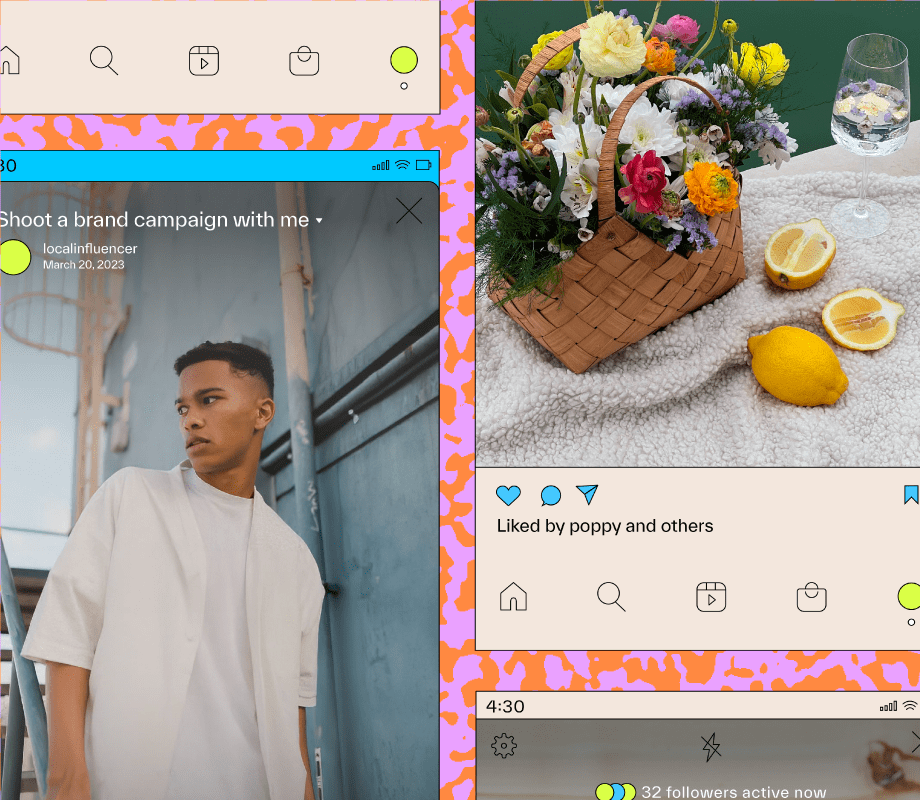If you’ve spotted the terms “faceless influencer” or “faceless creator” popping up on your feed, you’re not alone.
Full of aesthetic lifestyle shots and growth tips, the hashtag #facelessmarketing has over 150K posts on Instagram and 18K posts (and counting) on TikTok.

So, what is a faceless marketing creator, how do they differ from other faceless accounts, and where do we see this trend headed?
We’re breaking it all down, below.
Table of Contents
What Is a Faceless Influencer or Creator?
Simply put, a faceless influencer or creator is someone who creates content without showing their face.
And while there has been a recent uptick in “faceless marketing creators”, the concept of being a “faceless” account isn’t new (more on that, later).
The New Wave: Faceless Marketing Creators
Faceless marketing creators are primarily focused on selling digital products, courses, and templates.

But with their quick-growth strategies, some have questioned their credibility.
“A lot of the new ‘faceless marketing’ accounts I’ve seen have similar aesthetics, formats, and product offerings — which can become quite repetitive,” says Later’s Content Marketing Director, Nikki Canning.
“And when we see a surge of people jumping on a trend like this, especially on platforms that are rooted in sharing unique and creative content, it makes you wonder if you’re purchasing from a business you can trust,” she adds.
While there is money to be made as a digital marketer, it takes time, consistency, and a solid portfolio to build a reputation and recurring clients — whether you’re a faceless account or not.
So, don’t expect huge wins straight away!
The Old Guard: Faceless Influencers and Creators
The concept of not showing your face on social media isn’t new — just look at meme accounts like Saint Hoax or travel accounts like This Time Last Week.

And while showing your face does help to build connections and relatability, “going faceless” could become a more popular avenue for influencers and creators setting firmer boundaries online.
“I think it’s an interesting way to maintain privacy while taking advantage of the benefits that can come with being a successful creator,” says Later’s Social Content Lead, Lindsay Ashcraft.
“Food accounts like Men With Pot rarely show their face, but they've had longevity by providing value and sharing interesting content — not just aesthetic clips.”
The takeaway? Faceless accounts can be legitimate too, and those who hone their creativity and storytelling skills will stand out from the crowd.
FYI: With Later's influencer program, you can get discovered by major brands, access creator tools, and land dream partnerships. Learn more.
3 Benefits of Being a Faceless Influencer or Creator
There’s plenty of benefits to showing your face on social media. In fact, many marketers and creators will encourage you to do so — and for good reason!
That said, going faceless has its own perks. Here are three benefits to becoming a faceless influencer or creator:
#1: More Privacy
Last year, we surveyed over 600 content creators about social media burnout.
And we discovered that 80% felt there’s a cost to being authentic on social — with most fearing judgment, negative comments, or a loss of privacy.
As one creator put it: “Everyone knowing everything about you can be draining and uncomfortable.”
If followers don’t know who you are, you’re able to build stronger boundaries around your interactions, create less parasocial relationships, and maintain a sense of privacy.
To read our full creator burnout report, download it here.
#2: Less Pressure To Always Be “On”
When your brand is built around one person, there can be additional pressure to always be “on” — which can quickly lead to burnout.
Plus, it can risk a sort of “self obsession” as lifestyle influencer Ana Wolfermann recently shared:
“I’m tired of making everything about myself. My job requires me to look at myself, talk about myself, post myself, and then reply to comments about myself.”
While going faceless won’t protect you from the pressure to grow (and engage) on social, it does give you some distance from centering content around your entire life.
#3: More Authority In Your Niche
The last benefit to being a faceless creator? Letting your content do the talking for you.
“I think there’s niches where faceless works really well and can actually give the creator more authority,” says Chantal Hermetz, Later’s Social Media Specialist.
“Within the cooking niche, influencers and creators who dedicate their entire feeds to recipes have super engaged audiences who know they’re going to get high-quality content,” she adds.

Chantal points to creator Gillie Houston as someone who does this well:
“We know what her kitchen looks like, which creates a sense of familiarity, and she jumps right into the good stuff.”
Interestingly, there’s been a growing trend of foodie content — with agency execs noticing a 30% increase in client demand for food creators.
Our hypothesis: As the saying goes, we “eat first with our eyes,” so faceless food influencers and creators are able to capitalize on making their recipes the primary focus.
But before you put all your eggs into the “faceless” basket, it’s important to remember that becoming a successful creator won’t happen overnight — so don’t expect opportunities, brand deals, or virality right away.




